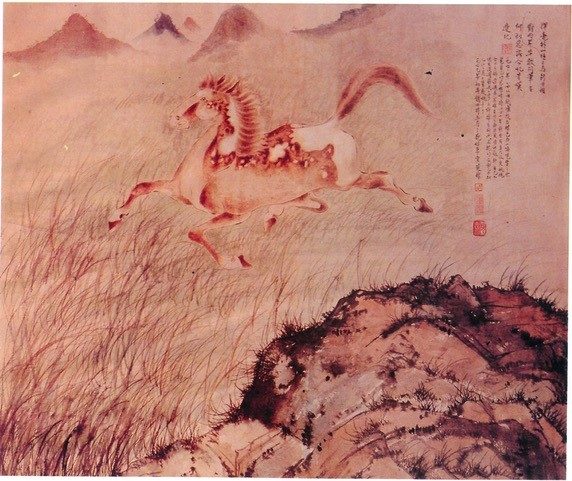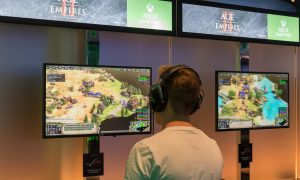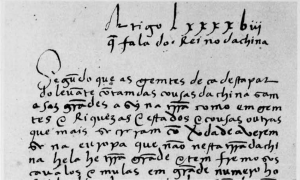The question of what makes Indonesian art Indonesian is by no means a new one. When debates around national identity arose in the wake of the Indonesian National Revolution, the task of defining “ke-Indonesia-an” (“Indonesianness”) became inseparable from developments in the realm of arts and culture.
Perhaps the most notable outcome of such contentions was the writing of an art history that memorialised several male Indonesian painters as the father figures of modern Indonesian art. These included the European-educated painter Raden Saleh (1911-1990) and the self-taught painter Sindudarsono Sudjojono (1913-1986)—two artists who frequently vie for the title of Indonesia’s first modern painter in accounts of visual modernity in Indonesia.
The modern art canon which emerged thus was one based upon a rivalry between the colonial and anti-colonial; the foreign and the indigenous; the Dutch/Dutch-influenced male painter and the Indonesian male painter. Yet, as scholars now point out, such narratives leave little room for ethnic and/or gendered difference. How and where might, say, the experience of a Chinese-Indonesian woman artist be located in Indonesian art history?
In spite of contestations over the nationality status of Chinese-Indonesians, the Chinese ethnic minority has occupied crucial positions in Indonesia’s economic and cultural development. More recent works have sought to re-evaluate the contributions of the Chinese minority to Indonesian society, including their role in shaping ideas of what it meant—and looked like—to be a modern Indonesian, through studio and amateur photography, as well as the visually diverse works of art they produced in the early-to-mid twentieth century. These studies go a long way to dispelling the myth of Indonesia as a homogenous national entity, encouraging us to look for alternative perspectives and instances of cross-cultural exchange that trespass the boundaries of the nation-state. In their attempts to do so, however, they often still overlook or omit the gender factor, inadvertently upholding the masculinist standards that skew our understanding of modern Indonesian art. Thus, the question remains: where are the Chinese-Indonesian women?
Retracing and recovering their lost stories can be a difficult process. Very few women of Chinese descent are recorded in historical accounts of Indonesian modern art or in the collections and archives of Indonesian cultural institutions. Despite such obstacles, the importance of bringing to attention the forgotten stories and transnational experiences of women who held fluid cultural identities, however fragmentary, should not be overlooked. Not only are transnational women’s histories human histories after all, but their retelling also unveils the intersecting structures of patriarchy and nationalism that have for so long limited historical perspectives.
The difficulty of the process, and the elusiveness of women’s stories, means that it can feel remarkably fortuitous to come across their names in scholarship. My first encounter emerged from conversations with an academic mentor, who directed me toward the recently translated writings of a Chinese-Indonesian art critic, Oei Sian Yok (1926-2002). Between 1956 to 1961, Oei wrote hundreds of articles reviewing both international and Indonesian exhibitions for the Jakarta-based Star Weekly magazine, under the pseudonym Pembantu Seni Lukis Kita (Our Art Servant). At the time of publishing, the Chinese community in Indonesia faced discriminatory legislation that sought to address their ambiguous nationality status. Notably, the signing of the Sino-Indonesian Dual Nationality Treaty between China and Indonesia in 1955 forced Chinese Indonesians to choose to remain as citizens of just one country. In following years, the Chinese minority in Indonesia continued to suffer from repression and violence during the New Order era, which sought to efface all aspects of Chinese culture and language. Such a position of precarity can be discerned in Oei’s articles, which appeared to pave an alternative way of appraising art that overturned the binary antagonism between colonial and anti-colonial viewpoints. Contrary to the incendiary rhetoric of an Indonesia-centric, nationalist historiography of art, Oei wrote:
When we listen to foreigners talking about our own country, sometimes we don’t recognize what they say as something of our own anymore. They often hear or see something that we couldn’t perceive, because we have taken things around us for granted, as being ordinary; foreigners might rediscover things for us because they see with the “other eyes”.
Here in Oei’s writings, in which she acknowledges and affirms the contributions of “foreign eyes” to the Indonesian artistic imaginary, we glimpse a genealogy of transnational thinking in Indonesian art criticism. Implicit in her writings, is the provocation that the very idea of Indonesia as a modern nation has, and may very well continue to be, shaped by those who occupy ambiguous, transnational positions in the country—the internal “other”.
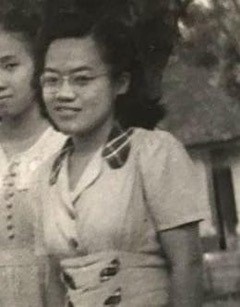
Portrait of Oei Sian Yok, photograph taken in 1953. Source: Wikimedia Commons.
Not long after, I chanced upon an inconspicuous album of paintings titled Lukisan Tradisional Tiongkok Karya Chiang Yu Tie (The Traditional Chinese Paintings of the Artist Chiang Yu Tie) in the digital recesses of the University of Sydney’s library catalogue. Piecing together scattered fragments of information, gleaned from Indonesian language blog posts, and just one journal article, I came to know the Chinese Indonesian painter Chiang Yu Tie (1916-2000).
Born into a wealthy and politically conservative family in Zhejiang Province, China, Chiang went on to study European painting at the Xinxi State Academy of Painting in Chongqing despite her family’s disapproval, graduating in 1945. After falling ill three years later, Chiang migrated to Indonesia in 1948, where she eventually settled in Bandung as an art teacher and founded her own painting studio called Rumah Rumput.
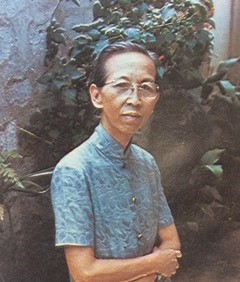
Portrait of Chiang Yu Tie, photograph taken in 1980. Source: Wikimedia Commons.
Like many of her contemporaries, Chiang’s paintings often feature Balinese landscapes and dancing Balinese women. The popularity of Bali as a subject matter amongst Chinese émigré artists in Southeast Asia speaks to their unique frame of mind, which encompassed a fascination for the exotic new world they now found themselves in, and a desire to express as authentically as possible this local reality, in an artistic language familiar to them. Oei attests to this endeavour to attain a true and faithful image of Bali, without its “make-up” (tanpa make-up):
In fact, there are two versions of Bali, one being the Bali that is known by travellers, with all its make-up, designed to show off to tourists…Then there is also a real and genuine Bali, which is often unknown to visitors, because it is difficult to find, and the road is narrow…
However authentic, this dualistic vision of Bali, distilled through the othering, touristic gaze of Chinese artists, would occupy an influential position in burgeoning national, and international, imaginaries of Bali, and more broadly, Indonesia.
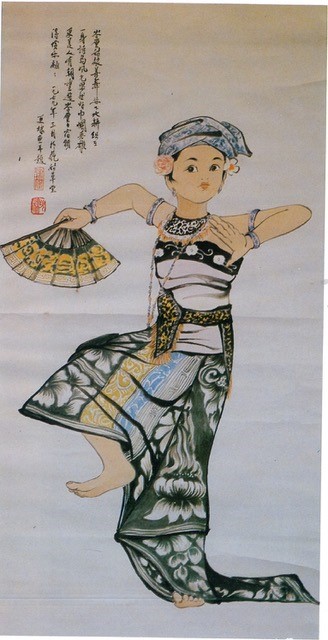
Chiang Yu Tie, Balinese Girl, 1979, ink on paper, dimensions unknown. Private collection. Reproduced with permission from Teng Mu Yen, 2022.
In applying a feminist reading of Chiang’s works, however, we are invited to consider how the construction of a national imagination of Indonesia is also inflected by gendered difference. Are there, perhaps, alternative ways of cultivating a sense of Indonesian cultural identity that not only permits ethnic diversity, but also shifts away from the troubled and deeply gendered narratives of a singular artistic genius, or an exclusive chronology of “stylistically original”, representative works from (male) artists?
As we revisit Chiang’s works, we are offered an alternative point of view that defies rigid categories of colonial and anti-colonial time as well as patriarchal valuations of “good” art and “Indonesian” art in terms of originality, genius, and rivalry. In a painting titled, Kuda Lari (Galloping Horse), Chiang’s inscription quite literally poses a question to its viewers, reflecting on the constructed notion of artistic originality:
Day after day, two years have already passed…The new meets old. The old “horse” is elevated by a “mountain”. An artist is just a creator. Who knows, what do you think?
Chiang is likely to be referring to the idea of developing an individual art style through a discerning approach to imitation, which dates to Qing Dynasty China. Certainly, her chosen subject—a galloping horse—is one which bears a long lineage in Chinese art. In this sense, her work testifies to the presence of a Chinese line of thought in the history of Indonesian art. Viewed in hindsight, with a heightened mindfulness toward the exclusionary nature of canonical history, her paintings provide respite from totalising, gendered narratives of nationhood and post-colonial identity, offering an expanded definition of “the artist”, and who could lay claim to that title.

Chiang Yu Tie, Galloping Horse, 1970, ink on paper, dimensions unknown. Private collection. Reproduced with permission from Teng Mu Yen, 2022.
Many of her retellings of wayang stories also offer a space in which a feminine sensibility may reside. In a work painted in 1979, titled Srikandi dalam sayembara panahan (Srikandi in an archery competition), Chiang depicts Srikandi, a character from Javanese wayang born as a male but later transformed into a female (although the gender transition is reversed in the Hindu epic Mahabharata), who has been retrospectively turned into an icon of feminism and women’s emancipation in Indonesia. An inscription in the upper left-hand side details the story of the heroine in first-person narration:
I used to be a student of archery. Now that I am skilled, let’s compete. If I should lose, I will become your concubine.
An English translation provided in the exhibition catalogue adds a final line: “…but if I were victorious, I would refuse to give [my] hand to thee.”
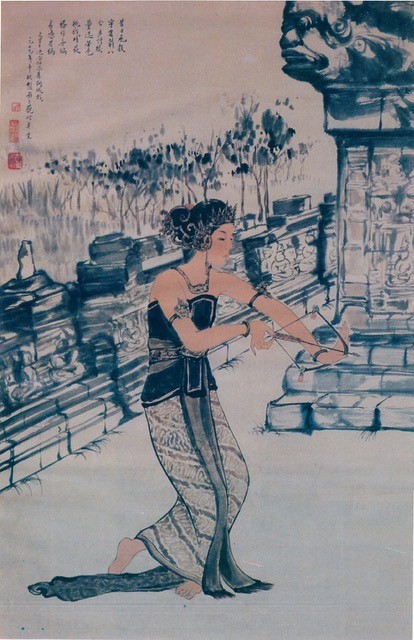
Chiang Yu Tie, Srikandi dalam sayembara panahan, 1979, ink on paper, dimensions unknown. Private collection. Reproduced with permission from Teng Mu Yen, 2022
Accompanied by defiant first-person inscriptions that seem to divulge the artist’s personal voice, Chiang’s selective renderings of wayang characters leave us to wonder about the hidden workings of women’s agency in the transmission of stories and images across time and space, outside of the established canon of Indonesian art history. This resistance against masculinised, nationalistic grand narratives is, in part, also generated as we connect with such works in the present-day. It is between Oei and Chiang’s practice in the twentieth century, and our patient, persistent attempts to revisit their works with an open-mindedness and receptivity, that we find capacity to dismantle those totalising narratives that so rigidly police our ideas of who can and should be a modern Indonesian artist, and what modern Indonesian art should look like.
Undoubtedly, more research is required to recover such stories and figures lost to canonical history—the translation of Oei’s work marks only a preliminary foray into the subject matter. Even so, the ripples of their impact can be gleaned today: in 2012, over a decade after her passing, 51 paintings by students, many women, taught by Chiang and her daughter, Teng Mu Yin, were exhibited by the Ikatan Wanita Pelukis Indonesia (Association of Indonesian Women Painters) in Bandung.
As the works of Chinese-Indonesian women artists and art critics are brought to light, they invite us to rethink the narratives and structure that have long been held up as part of an authoritative history. By making room for transnational and gendered experiences in the reading and writing of history, we may begin to uncover a far richer and multifaceted picture of Indonesian art and identity.
***
The author is grateful for support provided by the Sydney Southeast Asia Centre through its Residency scheme.
 Facebook
Facebook  Twitter
Twitter  Soundcloud
Soundcloud  Youtube
Youtube  Rss
Rss 